One small step for EV-kind
This is a second view of the 2016 Nissan Leaf SL—Clean Fleet Report’s previous review with additional technical detail appears here.
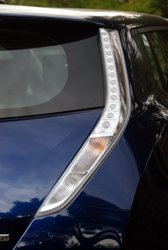
Let’s face it—the 2016 Nissan Leaf is not a moon shot, but it is a great step forward for the best-selling affordable pure electric vehicle on the market. It will never challenge the Tesla’s power, range or advanced technology, but then again it will never be three times its current price like the Model S.
The Leaf is the quirkily styled EV king of the hill, the leader of the pack. It remains the benchmark for the segment because of sales. Of course, now it lags behind not only the Model S, but the new Model X, so even the sales accolades rate an asterisk.
The Magic Number
So what is the great step forward for middle-class electric transportation? I saw it the first time I charged the 2016 Nissan Leaf—119 miles of range. Not last year’s 80 mile range; not a nominal boost to 90, but the promise of well beyond 100 miles of silent driving on electrons.
Nissan also boasted of being able to get to close to that range in just beyond three hours of Level 2 charging. This strikes another blow against range anxiety and puts this EV closer to an everyday vehicle.
Of course, a 75 mph run down the freeway, following by some stop-and-go driving over the course of a half-hour and 30 miles dropped the range to 79 miles, but returning to home base was a piece of cake and after a 60 mile round trip that include a good stretch of freeway I still had 34 miles of range. The Nissan has become a really functional EV.
EV Driving Unchanged
While the new battery (not a 30 kWh lithium-ion one with a 6.6 kW on-board charger) marks a major upgrade for the 2016 Nissan Leaf, not much in its approach to driving has changed. The Leaf
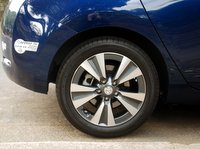
is not a driver’s car. It’s smoothly quiet and has adequate power to acquit itself on the highway and around town. Like most EVs, it’s quick off the line but the low rolling resistance tires, even wrapped around the 17-inch rims found on the SL (and SV) model, offer just adequate support if your driving style tends toward the aggressive. Then again, it seems unlikely an aggressive driver will end up behind the wheel of a Leaf based on the typical demographic of an electric vehicle owner.
Distinctive Design
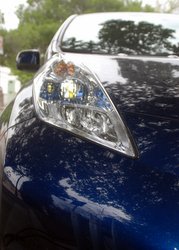
We’ve already noted the quirky styling of the 2016 Nissan Leaf. Its looks are unchanged since the Leaf first appeared in 2010 other than a few color changes. It looks like Nissan’s approach is love it or leave it, an approach they’ve broached with other models such as the little Juke.
The car continues to sport that most practical of formats—a hatchback. Twinned with the quirky styling, it almost becomes a question seems as though Nissan is challenging EV intenders with a mantra of eco-lifestyle:
- You must be instantly recognizable so people can know you’re dedicated to saving the earth (or collecting stickers that allow solo driving in the HOV lanes in California).
- You must be practical because nothing says practical like a hatchback.
Or is it just that an EV must cover as many potential customer segments as possible, adding the hatchback to a sedan to expand its appeal?
Inside Also More of the Same
So many years, so little change. Little inside the Leaf has evolved since 2010. It’s got the variety of visual displays of the activities going on under the hood and a seven-inch color display screen (in
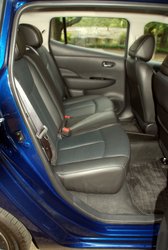
the SL and SV models, smaller version on the entry-level S model). The HVAC system remains a far from intuitive experience. It commits the cardinal sin by offering no dials to easier operate its various features.
The rear seat of the Leaf folds and then the capacity and functionality of the car changes. But it does not fold flat so don’t think this will work as an SUV substitute. The rear seat is straight up; it provides plenty of headroom, not it’s not a real five-passenger vehicle. You can fit three adult males in that rear seat without a fight breaking out, but it’s a bit of a squeeze.
Finally, the Most Important Change
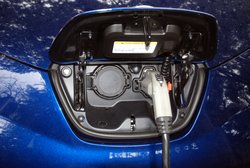
So much seems unchanged about the Leaf it could be easy to overlook the big change this year. The most important thing about an electric car is its battery. So a 27 percent increase in range is a big deal. Of course, all the talk about the 200+ mile range Chevy Bolt and Tesla Model 3 has taken some of the punch out of the announcement. Other automakers have likewise said they’ll be increasing the range of their EVs, but the 2016 Nissan Leaf beat them to the punch once again.
Although an increase in prices comes with the additional range, the Leaf remains one of the truly affordable EVs; one with six years of battle-hardened experience that assures you’re not going to be a beta-tester for some engineers’ overachieving designs. Extended range versions start at around $34,000, but lease deals abound and some include perks like free charging. Nissan’s singular achievement of boosting range while still holding onto an affordable price promises to keep them leading the affordable EV pack for some time.
Related Stories You Might Enjoy:
Update: 2016 Nissan Leaf
Road Test: 2013 Nissan Leaf
Road Test: 2016 Fiat 500e
The Best-Selling Electric Cars in the U.S.
Road Test: 2014 Ford Focus Electric
Road Test: 2014 Volkswagen e-Golf
Road Test: 2014 BMW i3 & i3 REX
First Drive: 2015 Kia Soul EV
Disclosure:
Clean Fleet Report is loaned free test vehicles from automakers to evaluate, typically for a week at a time. Our road tests are based on this one-week drive of a new vehicle. Because of this we don’t address issues such as long-term reliability or total cost of ownership. In addition we are often invited to manufacturer events highlighting new vehicles or technology. As part of these events we may be offered free transportation, lodging or meals. We do our best to present our unvarnished evaluations of vehicles and news irrespective of these inducements.
Our focus is on vehicles that offer the best fuel economy in their class. We also feature those that are among the top mpg vehicles in their class. In addition, we aim to offer reviews and news on advanced technology and the alternative fuel vehicle market. We welcome any feedback from vehicle owners and are dedicated to providing a forum for alternative viewpoints. Please let us know your views at publisher@cleanfleetreport.com.

0 thoughts on “Road Test: 2016 Nissan Leaf SL”